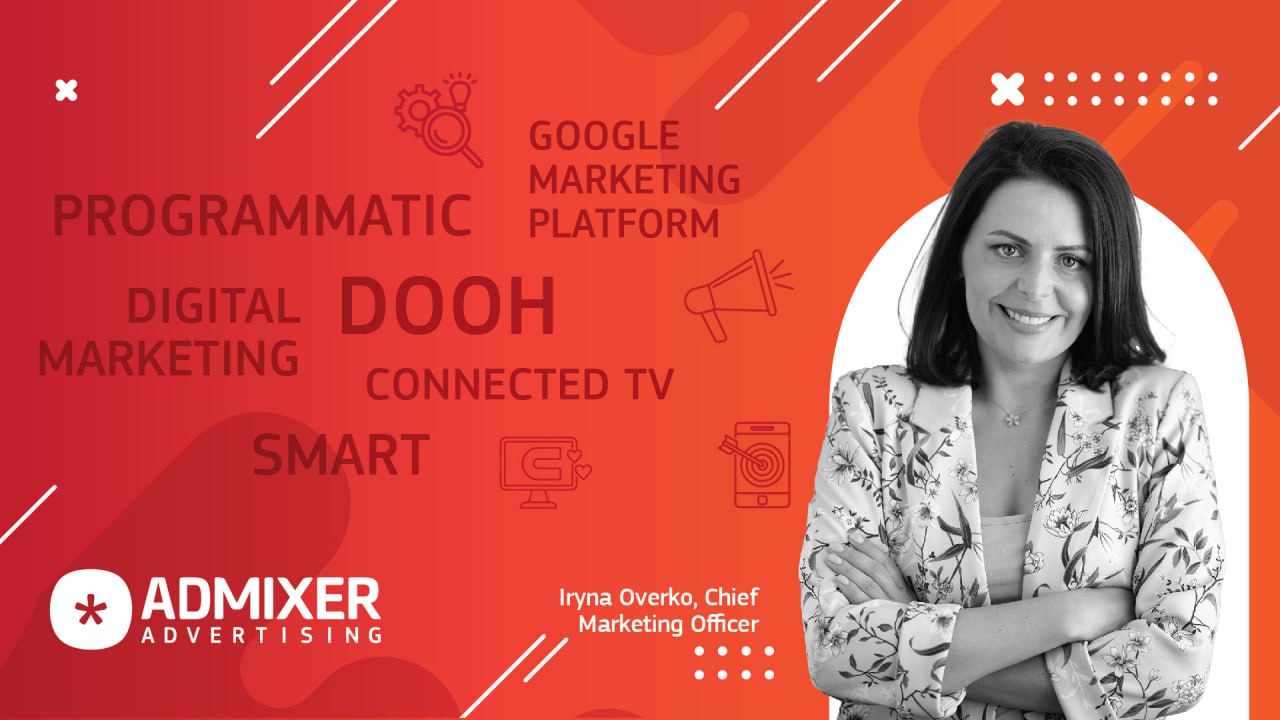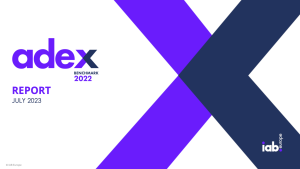This year, Admixer Advertising’s team of experts will be sharing their knowledge on various marketing-related subjects on Georgian TV. The upcoming business program, Business Partner, is set to immerse viewers in the world of digital marketing, offering insights into the latest trends, essential tools, and effective strategies to supercharge your marketing endeavors.
Over the course of 15 episodes, viewers will explore a wide range of critical marketing topics, with the industry experts providing invaluable commentary and analysis. To kickstart this captivating journey, our Chief Marketing and Strategy Officer, Iryna Overko, has granted an exclusive interview, designed to pique your interest and ensure you don’t miss a single episode of this engaging series.
We are thrilled to offer our readers the opportunity to gain unique insights into Iryna’s perspective on the evolving marketing landscape, cutting-edge approaches, and the essential tactics that every marketer should resort to. Read on as we delve deep into the exciting world of digital marketing in 2023 and unlock a world of possibilities.
What are the primary benefits that businesses should consider when implementing digital marketing strategies?
First and foremost, I want to outline the integration of digital and traditional marketing. Despite the different channels employed, the fundamental principles of marketing remain similar. At its core, marketing aims to establish a connection with consumers, effectively convey a product’s value proposition to the target audience, and ultimately achieve specific business objectives.
It’s evident that digital marketing offers more than enough advantages for nearly any business, considering the pervasive presence of digital media channels. Marketers can choose for advertising websites, applications, and platforms like Google and Meta, and Connected TV.
The specific benefits derived from digital marketing, however, are highly contingent on a business’s unique objectives. Digital marketing boasts an array of upsides, including its reach capabilities, which can be tailored to suit broad or highly targeted audiences. Additionally, it offers a diverse range of formats such as video, banner ads, search engine marketing, audio advertising, content marketing, and user-generated content. Furthermore, digital marketing extends its reach across various devices, spanning desktop computers, smartphones, TV sets, and even game consoles.
One notable attribute of digital marketing is its versatility in navigating different stages of the marketing funnel. Whether you aim to raise brand awareness, captivate consumer attention, guide decision-making, or drive immediate action, digital marketing offers an extensive selection of formats and targeting options to match your objectives.
For those focused on brand building, the expansive reach of banner and video formats can be harnessed effectively. Conversely, if your goal is to boost sales through a direct response campaign, you can capture intent through search engine marketing or leverage cutting-edge AI tools like Meta’s discovery commerce, among many other strategies.
Can you elaborate on the latest trends in programmatic advertising, its evolution, and the notable pros it offers in the present day?
When programmatic first appeared, it served as a platform for acquiring remnant inventory at a reduced cost. However, in today’s landscape, the programmatic ecosystem has expanded significantly, including tens of thousands of players. They are innovating with various technologies and services, all aimed at enhancing the efficiency of digital advertising.
It’s crucial to note that programmatic represents an automated approach to procuring digital ads through technological means. This transformation is exemplified by the fact that, according to the ADEX report from IAB Europe, a substantial 58% of display ads are now acquired through programmatic methods, firmly establishing it as a mainstream advertising avenue.
One of the standout advantages of programmatic lies in its automation capabilities, which not only streamline the ad buying process but also contribute to workforce optimization and the improved performance of advertising campaigns. Furthermore, the expansive infrastructure of programmatic advertising offers an extensive inventory selection, catering to a wide range of needs. However, it’s important to acknowledge that programmatic advertising faces its fair share of challenges that the industry is actively addressing.
For example, Supply Path Optimization, or shortening the supply chain of ad inventory and trying to eliminate intermediaries that do not bring value. Or over-reliance on 3rd party cookies for targeting and frequency capping is also among the hurdles that require careful navigation. With the time of 3P cookie deprecation getting closer, the industry is still grappling with finding effective solutions.
As digital marketing platforms continue to evolve, what are the top trends expected in the field for 2023 and how will 2024 differentiate itself?
AI technology is undeniably the main trend within the ever-evolving landscape of digital marketing platforms. The platforms fiercely compete for advertisers’ budgets in the wake of a global economic downturn. Hence, they try to provide more efficient tools that give better results. In my opinion, it’s a great tendency for advertisers.
Other trends encompass the diversification of new media capabilities in terms of formats. Such as:
- Digital Out of Home (DOOH) that takes 25% of overall OOH spends and can be bought programmatically;
- Connected TV (CTV) development with linear TV inventory that is watched through digital channels and can be monetized via technologies such as SSAI/DAI. Or additional way of content consumption – FAST TV channels development that is developed and monetized by OTT-platforms;
- Retail Media – a new concept which enables e-commerce players to unlock additional monetization while brands can capture audiences with a strong purchase intent.
With digital media taking a larger pie of our time we will see further new opportunities emerging.
While success metrics for digital channels may vary, based on your experience and client needs, what are the most sought-after key performance indicators (KPIs) for businesses?
As mentioned, KPIs setting in the digital realm should be closely aligned with specific business objectives. Different brands have varied priorities. For some, it’s all about expanding reach and fostering awareness, thus prompting the use of KPIs like audience reach and brand lift measurements. Others are primarily focused on generating leads and driving conversions.
It’s important to note that when it comes to KPIs, we shouldn’t debate on their importance. Instead, the key discussion should revolve around the precision with which they are set and the accuracy while measuring. In my professional experience, I’ve encountered numerous cases where business objectives were not effectively translated into digital marketing KPIs for individual platforms, and subsequently, these KPIs were not consistently measured.
One highly effective framework for goal-setting is the SMART approach by Meta. SMART, an acronym, breaks down as follows:
S – Specific: KPIs should be clearly defined and specific in nature.
M – Measurable: If we couldn’t measure a KPI, it won’t serve us well.
A – Achievable: If you want to spend only $1.000 оn ads, but set unrealistically high reach targets, your efforts may be in vain.
R – Relevant: The chosen goals and KPIs should align closely with your specific needs. For instance, if your primary aim is brand growth, it makes more sense to prioritize KPIs related to target audience reach rather than mere video view counts.
T – Time-Bound: Establishing a timeframe for achieving the set KPIs is crucial, but shouldn’t put you in unachievable conditions.
Which new international products have recently entered the digital market?
In the global market, we haven’t witnessed significant new entrants recently. Currently, there’s keen anticipation surrounding the impending launch of Apple DSP, which, as per rumors, is expected to introduce a wider array of ad formats, including conventional in-app formats like interstitials. It’s worth noting that last year, Netflix initiated its foray into ad monetization and introduced an ad-supported subscription model in selected markets. This move has generated considerable interest among marketers in numerous countries and anxiety around possibilities to expand this geographically.
Furthermore, Elon Musk’s recent rebranding of Twitter as “X” and his ambition to develop a platform similar to the Chinese WeChat has ignited excitement within the industry. If successful, this project could potentially open up many new advertising opportunities in the future. Although its success is doubtful in my personal opinion.
In the context of the local Georgian advertising market, I want to note that major international products like Google Ads, Google Marketing Platform, and Meta are already available. However, there’s an existing limitation with YouTube monetization in Georgia, a challenge not unique to the region but one that Admixer Advertising is actively addressing. TikTok is not opening new markets for ad monetization either.
Admixer Advertising is also looking ahead to introduce innovative products to the market, particularly the retail media and Digital Out of Home (DOOH). We consider these ventures as part of a broader global trend, and we are committed to expanding our offerings in the CTV with the SSAI technology partnership.
The global podcasting industry is gaining momentum, while video and live-streaming, as well as influencer marketing, are becoming increasingly popular. How would you assess the current trends in these areas?
The IAB ADEX report provides insight that only 3.4% of display ad spend is allocated to digital audio, and this allocation doesn’t seem to be experiencing significant growth. This raises questions about the sustainability of this trend in the advertising landscape. Similarly, when it comes to live-streaming. I think that it’s apparent that its popularity varies across different categories, such as gaming or specific news channels. However, it might not be accurate to label live-streaming as a huge thing in the digital realm.
I believe that many of our media consumption habits, which were originally formed through traditional media, are undergoing a transformation in the digital sphere. Considering the role of TV in recent years, I suggest this type of media content and advertising to be developed further. Probably we’ll see new formats, as recently short forms of vertical videos became extremely popular due to TikTok, Meta and Youtube. Now we see a huge development of FAST TV-channels, niche channels for smaller audiences on OTT platforms. Or SSAI/DAI technologies that create possibilities to insert targeted ads to TV broadcasts and target specific digital viewers.
Influencer content will also develop. I see it as a part of a bigger trend towards lo-fi content. This trend is characterized by the preference of younger audiences, including millennials and zoomers, for unvarnished, authentic content drawn from real-life experiences. There are several studies confirming that low-quality content captured on mobile phones featuring real people works better for brands than top-notch commercials shot in studio with professional actors. Meta also underlines the importance of including influencer content in the mix, as it has been shown to enhance the effectiveness of advertising campaigns.
The Admixer Advertising’s team stands at the forefront of innovation and expertise in digital marketing. Committed to providing cutting-edge insights and strategies, our experts always seek for the latest trends and updates we’re gladly sharing. Following the latest trends, we continue to stay in the loop, emphasizing the pivotal role of programmatic ads and AI in enhancing campaign performance and audience targeting.
Stay tuned for more! Follow the Business Partner program and read the updates we’re sharing. Let’s together navigate the ever-evolving landscape of digital marketing!














